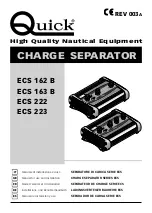
3
Design
Data
Installation
All Central Model ELO-16 GB FR
Automatic Glass Bulb Sprinklers must
be installed according to current NFPA
13 Standards and these installation
instructions. Deviations from these
requirements and standards or any
alteration to the sprinkler itself will void
any warranty made by Central Sprinkler
Company. In addition, installation must
also meet local government provisions,
codes, and standards as applicable.
The system piping must be properly
sized to ensure the minimum required
flow rate at the sprinkler. Check for the
proper model, style, orifice size, and
temperature rating prior to installation.
Install sprinklers after the piping is in
place to avoid mechanical damage;
replace any damaged units.
Upon completion of the installation,
the system must be tested per
recognized standards.
In the event of a thread leak, remove
the unit, apply new pipe joint compound
or tape, and reinstall.
Installation Sequence
Step 1. For Recessed Pendent
Sprinklers, the face of the sprinkler
fitting should be installed a nominal
3
⁄
4
"
(
±
3
⁄
8
") behind the ceiling line.
Adjustments are made via the push-on
escutcheon.
Step 2. Use only a non-hardening pipe
joint compound or Teflon* tape. Apply
only to the male threads.
Step 3. Hand tighten the sprinkler into
the fitting. Use the appropriate Central
wrench to tighten the unit into the fitting.
A leak-tight joint requires only 7 to 14
ft.-lbs. of torque; a tangential force of 14
to 28 lbs. delivered through a 6" handle
will deliver adequate torque. Torque
levels over 21 ft.-lbs. may distort the
orifice seal, resulting in leakage.
The upright sprinklers shall be
oriented so the frame arms are parallel
with the branch line pipe per NFPA.
*Teflon is a trademark of the DuPont Corp.
Caution: Minimum spacing between sprinklers is 12' for upright
and 12'-6" for pendent.
Design Requirements — Commercial Extended Coverage Applications
Ordinary Hazard, Group 3, Density 0.21 GPM/ft
2
- NFPA 13 1989 or earlier
Minimum Distance From Deflector to Top of Commodities is 18".
Maximum
Minimum Design
Minimum Design
Spacing Between
Location From
Flow per Sprinkler
Pressure per Sprinkler
Sprinklers
Any Wall
(gpm)
(psi)
14 x 14 feet (196 sq. ft.)
7 feet
41.2
13.1
16 x 16 feet (256 sq. ft.)
8 feet
53.8
22.3
Design Requirements — Commercial Extended Coverage Applications
Ordinary Hazard, Group 2, Density 0.20 GPM/ft
2
- NFPA 13 1991 and later
Minimum Distance From Deflector to Top of Commodities is 18".
Maximum
Minimum Design
Minimum Design
Spacing Between
Location From
Flow per Sprinkler
Pressure per Sprinkler
Sprinklers
Any Wall
(gpm)
(psi)
14 x 14 feet (196 sq. ft.)
7 feet
39.2
11.8
16 x 16 feet (256 sq. ft.)
8 feet
51.2
20.2
Maximum
Minimum Design
Minimum Design
Spacing Between
Location From
Flow per Sprinkler
Pressure per Sprinkler
Sprinklers
Any Wall
(gpm)
(psi)
14 x 14 feet (196 sq. ft.)
7 feet
37.2
10.6
16 x 16 feet (256 sq. ft.)
8 feet
48.6
18.2
Design Requirements — Commercial Extended Coverage Applications
Ordinary Hazard, Group 2, Density 0.19 GPM/ft
2
- NFPA 13 1989 or earlier
Minimum Distance From Deflector to Top of Commodities is 18".
Maximum
Minimum Design
Minimum Design
Spacing Between
Location From
Flow per Sprinkler
Pressure per Sprinkler
Sprinklers
Any Wall
(gpm)
(psi)
14 x 14 feet (196 sq. ft.)
7 feet
31.4
7.6
16 x 16 feet (256 sq. ft.)
8 feet
41.0
12.9
Design Requirements — Commercial Extended Coverage Applications
Ordinary Hazard, Group 1, Density 0.16 GPM/ft
2
- NFPA 13 1989 or earlier
Minimum Distance From Deflector to Top of Commodities is 18".
Design Requirements — Commercial Extended Coverage Applications
Ordinary Hazard, Group 1, Density 0.15 GPM/ft
2
- NFPA 13 1991 and later
Minimum Distance From Deflector to Top of Commodities is 18".
Maximum
Minimum Design
Minimum Design
Spacing Between
Location From
Flow per Sprinkler
Pressure per Sprinkler
Sprinklers
Any Wall
(gpm)
(psi)
14 x 14 feet (196 sq. ft.)
7 feet
29.4
6.7
16 x 16 feet (256 sq. ft.)
8 feet
38.4
11.3
For FM Projects
Consult the Factory Mutual Guidelines for
specific Factory Mutual requirements if Factory
Mutual Approval is required.
OBSOLETE






















